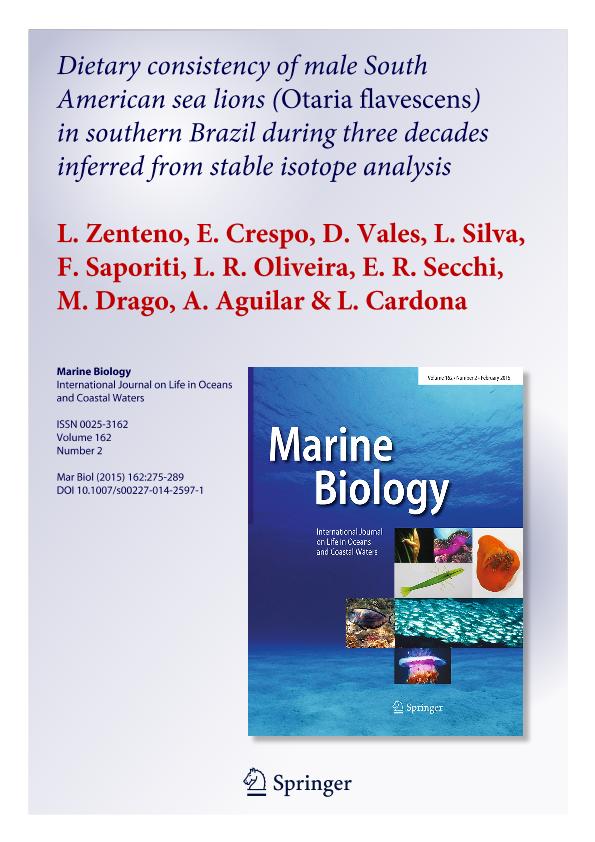Mostrar el registro sencillo del ítem
dc.contributor.author
Zenteno, Lisette

dc.contributor.author
Crespo, Enrique Alberto

dc.contributor.author
Vales, Damián Gustavo

dc.contributor.author
Silva, Laura Alejandra

dc.contributor.author
Saporiti, Fabiana

dc.contributor.author
Oliveira, Larissa R.

dc.contributor.author
Secchi, Eduardo Resende

dc.contributor.author
Drago, M.
dc.contributor.author
Aguilar, A.
dc.contributor.author
Cardona, Luis

dc.date.available
2017-07-27T17:46:06Z
dc.date.issued
2014-12-24
dc.identifier.citation
Zenteno, Lisette; Crespo, Enrique Alberto; Vales, Damián Gustavo; Silva, Laura Alejandra; Saporiti, Fabiana; et al.; Dietary consistency of male South American sea lions (Otaria flavescens) in southern Brazil during three decades inferred from stable isotope analysis; Springer Verlag Berlín; Marine Biology; 162; 2; 24-12-2014; 275-289
dc.identifier.issn
0025-3162
dc.identifier.uri
http://hdl.handle.net/11336/21470
dc.description.abstract
Marine predators may undergo remarkable dietary changes through time as a result of both anthropogenic and natural changes in the environment, but this variability is often difficult to tackle and seldom incorporated into ecosystem models. This paper uses the stable isotope ratios of carbon and nitrogen in skeletal material of South American sea lions from Brazilian scientific collections to investigate whether these animals modified their diet from 1986 to 2009, as reported for other marine predators in the region. Stable isotope ratios indicated that demersal potential prey were always enriched in 13C as compared with pelagic prey. Accordingly, the absence of any statistically significant correlation between stranding year and the δ13C values of adult males indicated no major increase in the consumption of pelagic prey from 1986 to 2009. Likewise, the results of the mixing model SIAR revealed a mixed diet including pelagic and demersal prey, with a central role for demersal fishes throughout the whole period. Furthermore, SIAR suggested no major changes in the proportion of pelagic and demersal prey in the diet of adult male South American sea lions during the past three decades. Demersal fishes were also relevant prey for juvenile South American sea lions during the whole period, but they always consumed a larger proportion of pelagic prey than the adults did. These results suggest no major changes in the diet of male South American sea lions during the past three decades in southern Brazil, contrary to what has been reported for other to predators in the regions and for the species in northern Patagonia.
dc.format
application/pdf
dc.language.iso
eng
dc.publisher
Springer Verlag Berlín

dc.rights
info:eu-repo/semantics/openAccess
dc.rights.uri
https://creativecommons.org/licenses/by-nc-sa/2.5/ar/
dc.subject
South American Sea Lion
dc.subject
Otaria Flavescens
dc.subject
Stable Isotope Analysis
dc.subject
Diet
dc.subject
Southern Brazil
dc.subject.classification
Ecología

dc.subject.classification
Ciencias Biológicas

dc.subject.classification
CIENCIAS NATURALES Y EXACTAS

dc.title
Dietary consistency of male South American sea lions (Otaria flavescens) in southern Brazil during three decades inferred from stable isotope analysis
dc.type
info:eu-repo/semantics/article
dc.type
info:ar-repo/semantics/artículo
dc.type
info:eu-repo/semantics/publishedVersion
dc.date.updated
2017-07-13T14:02:09Z
dc.identifier.eissn
1432-1793
dc.journal.volume
162
dc.journal.number
2
dc.journal.pagination
275-289
dc.journal.pais
Alemania

dc.journal.ciudad
Berlin
dc.description.fil
Fil: Zenteno, Lisette. Universidad de Barcelona. Facultad de Biología. Departamento de Biología Animal; España
dc.description.fil
Fil: Crespo, Enrique Alberto. Consejo Nacional de Investigaciones Científicas y Técnicas. Centro Nacional Patagónico; Argentina
dc.description.fil
Fil: Vales, Damián Gustavo. Consejo Nacional de Investigaciones Científicas y Técnicas. Centro Nacional Patagónico; Argentina
dc.description.fil
Fil: Silva, Laura Alejandra. Consejo Nacional de Investigaciones Científicas y Técnicas. Centro Nacional Patagónico; Argentina
dc.description.fil
Fil: Saporiti, Fabiana. Universidad de Barcelona. Facultad de Biología. Departamento de Biología Animal; España
dc.description.fil
Fil: Oliveira, Larissa R.. Study Group of Aquatic Mammals of Rio Grande do Sul ; Brasil
dc.description.fil
Fil: Secchi, Eduardo Resende. Universidade Federal Do Rio Grande; Brasil
dc.description.fil
Fil: Drago, M.. Universidad de la República; Uruguay
dc.description.fil
Fil: Aguilar, A.. Universidad de Barcelona. Facultad de Biología. Departamento de Biología Animal; España
dc.description.fil
Fil: Cardona, Luis. Universidad de Barcelona. Facultad de Biología. Departamento de Biología Animal; España
dc.journal.title
Marine Biology

dc.relation.alternativeid
info:eu-repo/semantics/altIdentifier/doi/http://dx.doi.org/10.1007/s00227-014-2597-1
dc.relation.alternativeid
info:eu-repo/semantics/altIdentifier/url/https://link.springer.com/article/10.1007%2Fs00227-014-2597-1
Archivos asociados
